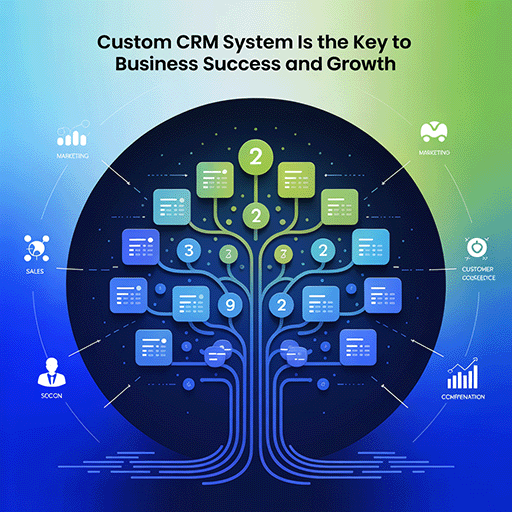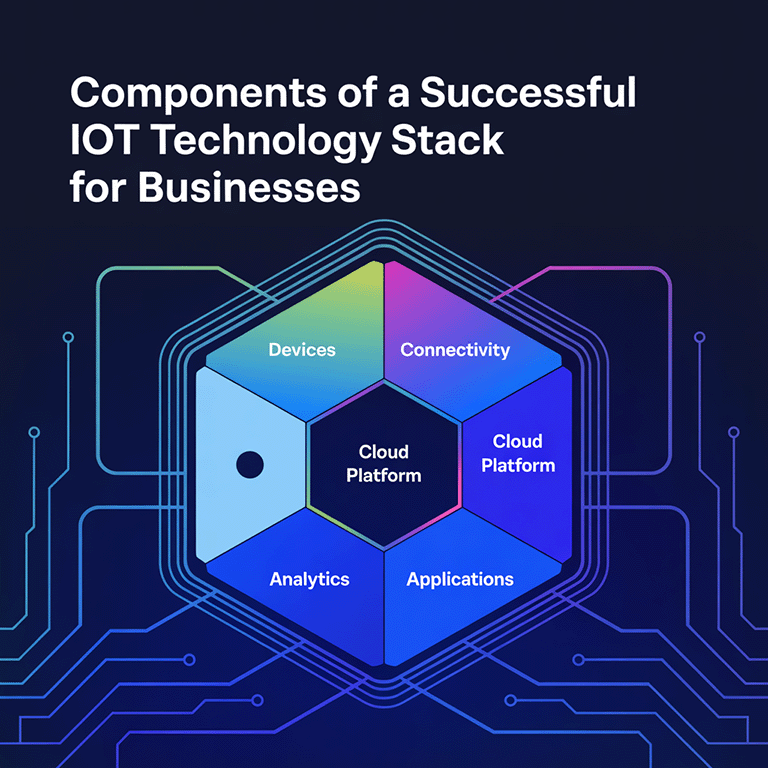Artificial intelligence is at the leading edge of new technologies, changing industries and personal experiences. Since its introduction, it has revolutionized our understanding of technology and how we relate to it.
In this article, we’ll explore the evolution of artificial intelligence, pointing out some critical milestones and how these developments have shaped society. We’ll also explain how artificial intelligence has evolved and what we can expect from it in the future.
The Role of AI in Revolutionizing Software Development
AI originated in the middle of the 20th century when people like Alan Turing started working on how machines could have intelligence. Over time, through improved algorithms and increased computational capacity, AI has evolved from mere ideas to tangible products. Thanks to the progress in machine learning, neural networks, and natural language processing, it is now possible to create intelligent systems that replicate the way people think more effectively than ever before.
An Accenture report says that 97% of world leaders feel AI foundation models will form unseen connections among diverse kinds of information and change the way AI works. Similarly, in the next 3-5 years, 98% think these models will critically constitute their companies’ strategies.
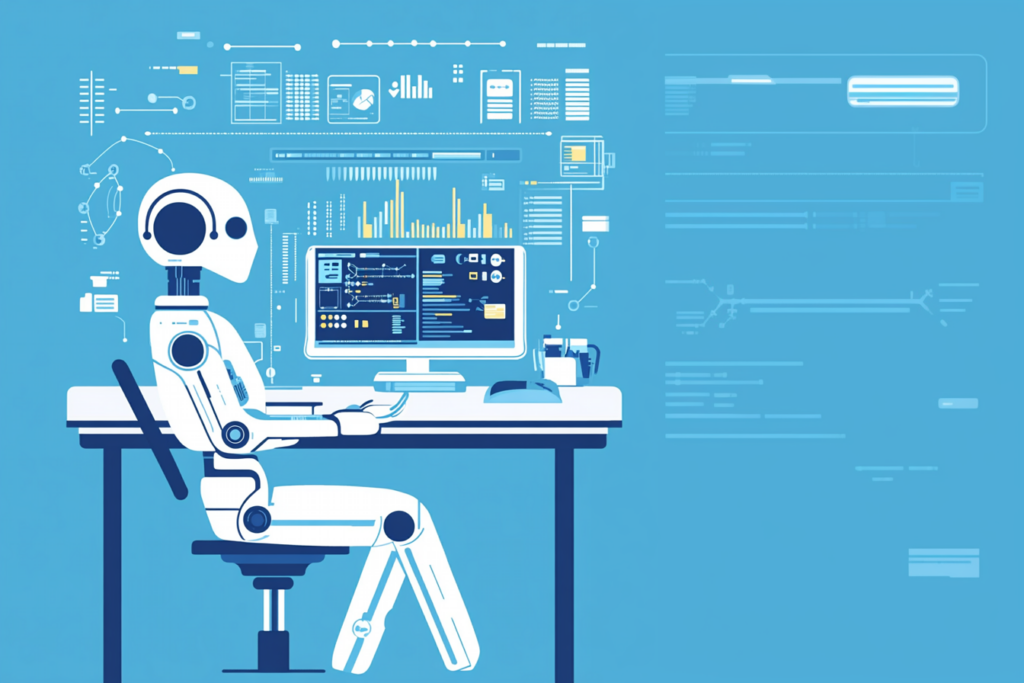
So far, AI is revolutionizing software development by automating monotonous jobs and rapidly speeding up coding processes. When it comes to generating code segments, among other uses like bug fixing or predictive analysis, AI reduces errors and saves time. By utilizing standard artificial intelligence tools, developers can now focus on more rewarding work like tackling complex issues or inventions instead of spending most of their time doing mundane tasks such as typing repetitive codes into their editors and debugging them.
Revolutionizing Code and Debugging with AI
The automation of coding and debugging processes by AI has led to significant improvements in productivity since it improves precision and increases productivity. In coding, AI tools such as GitHub Copilot and Tabnine, and automated code review systems help developers through code snippet suggestions, line completion, and whole function generation based on natural language input and/or code context. This speeds up development while minimizing errors as much as possible.
AI can scrutinize codes for bugs and potential challenges in future developments and even provide recommendations on their resolutions. The importance of this is that if there are any vulnerabilities you would like fixed instantly, all you have to do is use DeepCode or Snyk. Therefore, this results in cleaner codes, faster troubleshooting, and more dependable software production.
Transforming Project Management with AI-Driven Automation
AI is reshaping how projects are conducted through process simplification, improved decision-making, and increased efficiency. In this regard, artificial intelligence tools, such as Jira, Asana, and ClickUp AI, may automate basic operations such as resource allocation, scheduling, or tracking progress, thereby allowing managers overseeing projects to concentrate specifically on strategic plan assignments.
Innovatively managed enterprises now leverage Predictive Analytics on AI platforms that help them predict the consequences of various projects, identify possible risks, and recommend solutions driven by data, which facilitates proactive project management.
Additionally, AI increases conversational rates between departments by offering real-time information and updates, ensuring that every member is in line with the other members whenever they are working together. Hence, as projects become more data-intensive, managers can use AI to make smarter decisions, leading to successful project realization and delivery.
Revolutionizing Testing and QA with AI-Driven Automation
AI is changing the landscape of software testing and quality assurance (QA) by automating repetitive tasks, enhancing accuracy, and accelerating timeframes. AI-enabled instruments, like Testim, Mabl, and Applitools can build tests, run them, and interpret them with little or no human involvement, significantly lowering the time and labor demanded by manual testing processes.
By analyzing source code patterns and past information, AI can even anticipate possible breakdowns, allowing bugs to be identified sooner rather than later. As time passes, machine learning algorithms constantly refine these test cases, ensuring they will cope better with changes within software packages. This will lead to better software quality, quicker release cycles, and more reliable end products.
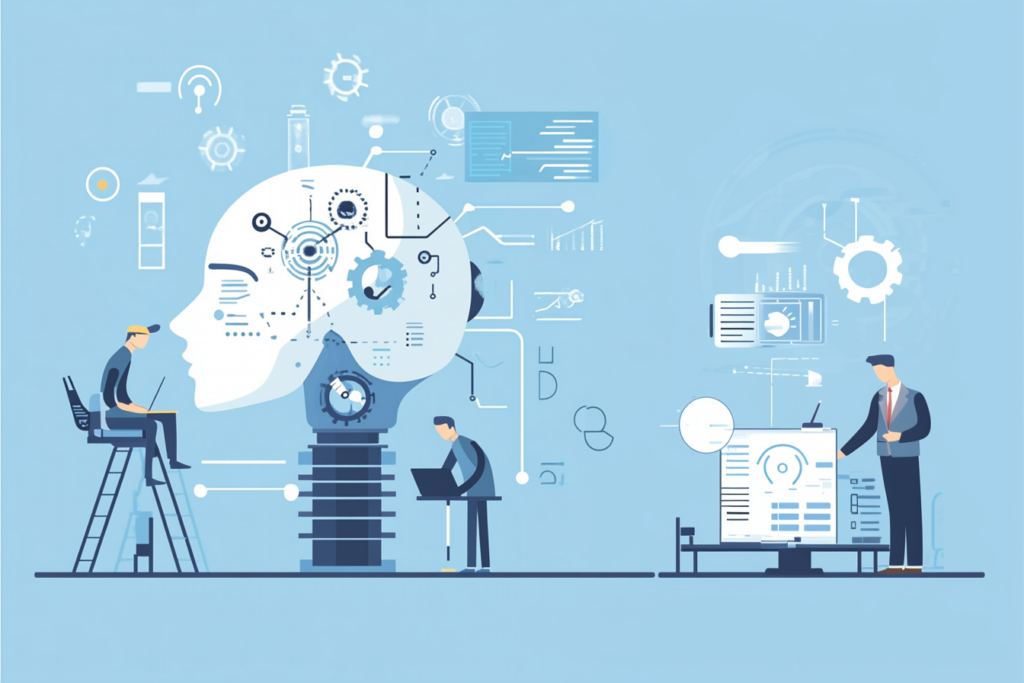
How AI Drives Efficiency and Reliability in DevOps?
AI transforms DevOps and deployment by leveraging automation, increasing efficacy, and boosting the reliability of systems. Streamlining CI/CD pipelines with AI tools similar to GitLab or Jenkins automates code builds, testing, and deployments, hence shortening release cycles.
AI-driven predictive analytics can be used to predict system failures, optimize resource allocation, or improve infrastructure management. AI-powered monitoring, on the other hand, helps identify and resolve problems before they affect the users, thus making applications stronger, more scalable, and less breakable while at the same time improving the general effectiveness of their operations.
Revolutionizing Software Design with AI
AI tools like Figma, Uizard, Autodesk Dreamcatcher, and more are revolutionizing software design and architecture. They offer sophisticated tools and methods to improve inventiveness, effectiveness, and precision. It can help to develop design patterns and architectural blueprints that are based on the data that exists as well as the user needs.
Machine-learning algorithms examine previous projects, thereby suggesting the best design options and preventing possible mistakes, creating stable systems that will last over time. In addition, AI tools help automate code writing while being compatible with design systems, thereby reducing lead times for development and enhancing general design quality. This results in creative resolutions and productive software creation flows.
Strategic Advantages of AI in Software Development
AI in software development presents significant prospects in terms of enhancing productivity and efficiency through simplifying routine tasks. Through automation of such activities as checking for errors or predicting future outcomes before coding begins, this technology ensures that bugs are eliminated right from the onset during coding, hence improving its quality.
Moreover, resource allocation for a project is optimized through AI in project management by identifying potential risks associated with each task and accounting for some uncertainties. Again, it enables the creation of sophisticated properties alongside personalized answers, leading to technological advancement in various companies. Other benefits include enhancing communications among teams while sharing knowledge among them to change the software development process at large.
In software development, there are many key ways that AI can be used.
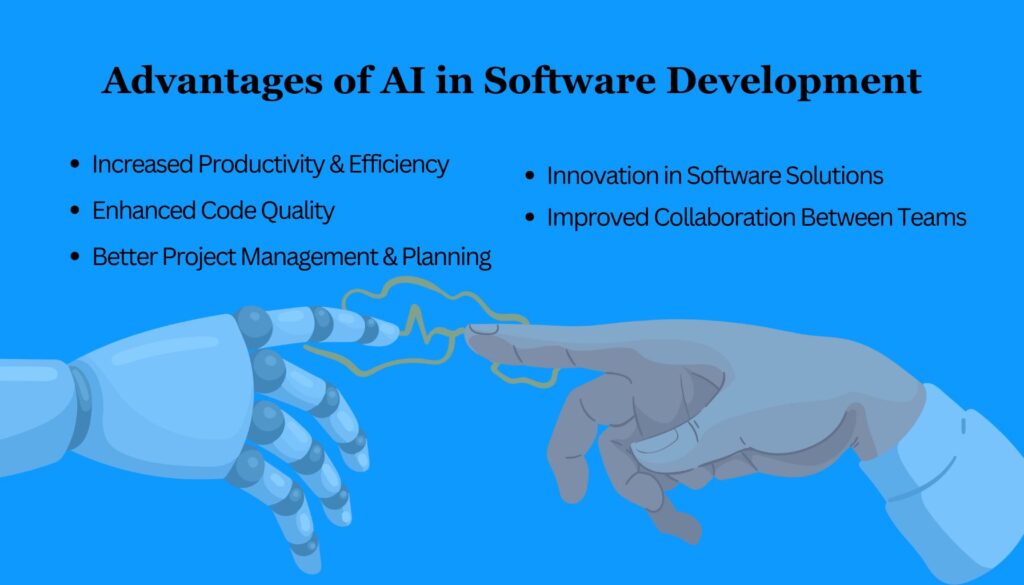
1. Increased Productivity and Efficiency
AI technology can automate repetitive tasks, like code generation or debugging, so developers have more time to work on complex questions.
Faster Development Cycles: By quickly identifying and solving problems, AI tools speed up project durations even if some issues remain unsolved.
2. Enhanced Code Quality
Algorithms Review Code Quality: Software engineers use AI when reviewing code for errors that might compromise its security level, as well as those bugs that might mess up the final product
Forecasting Mistake Prevention: AI could analyze past programming data, preventing it from causing trouble before it happens.
3. Better Project Management and Planning
Resource Allocation: AI should optimize resources if we are to make reliable predictions about the requirements of a particular project or adjust the time frame within which each task has to be completed.
Risk Management: AI systems can detect risks that could affect the success of a project. They also provide solutions for mitigating them, hence improving project outcomes.
4. Innovation in Software Solutions
Improved Capabilities: Cutting-edge technologies, such as artificial language processing and augmented intelligence, have been introduced to improve software application development.
Trendy Solutions: AI can help in creating customized solutions that are aimed at satisfying particular needs of the enterprise, therefore enabling it to be on top of its game
5. Improved Collaboration Between Teams
Better Communication: AI-based tools for managing tasks make communicating and coordinating among team members easier. They provide updates in real-time about what people are doing at any given moment.
Dissemination of Knowledge: Teams can learn from past projects by using AI to merge information from different sources, thus enhancing collaboration and performance.
These opportunities are indicative of how artificial intelligence may revolutionize software development to increase efficiency and enhance quality by harnessing project management and teamwork.
Navigating the Challenges of AI in Software Development
One of the problems associated with artificial intelligence is a significant deficit in the skill set of developers as well as a steep curve in learning. This can lead to AI algorithms that may be biased, leading to ethical issues, and data privacy or security challenges also come into play when dealing with such situations.
Using tools that depend too much on artificial intelligence can lead to over-reliance on these technologies instead of engaging their brains when solving problems critically or creatively.
Other complications, like the costly nature of AI integration and limited resources, make it difficult for most entities to afford such innovations.
Read our article on how to overcome AI challenges and find 6 steps to easily adopt AI.
Here is the list of the common challenges.
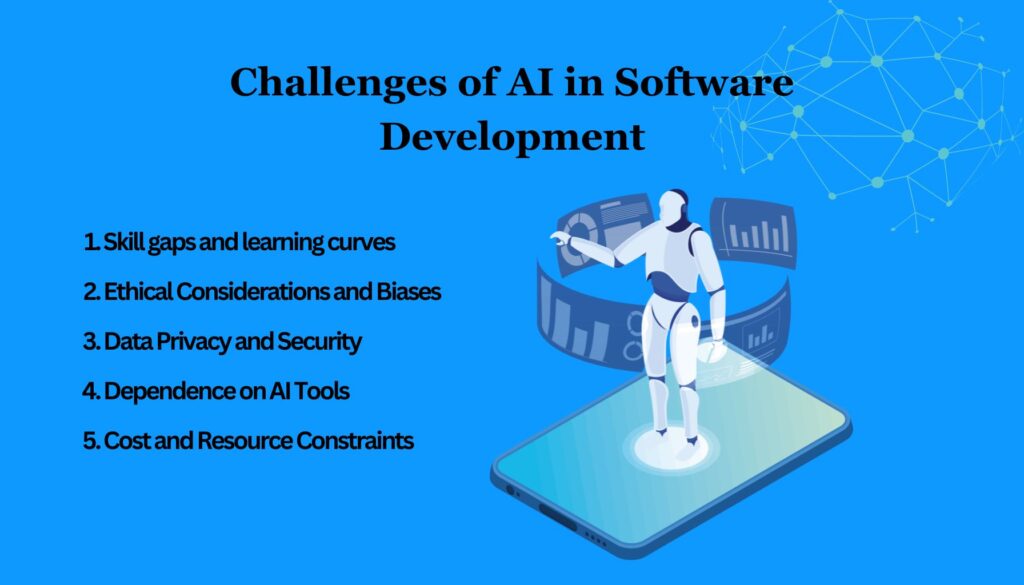
1. Skill gaps and learning curves
Technical Expertise: Using AI demands special skills that many developers lack and are becoming hard to learn quickly, leading to possible skill gaps within their teams.
Continuous Learning: Continuous training and the acquisition of skills are required to catch up with the rapid growth of AI technology. By the way, not only do people need to acquire special knowledge to use AI, but AI can also help them in the learning process. Read our blog to learn more.
2. Ethical Considerations and Biases
Algorithmic Bias: The models may exacerbate or perpetuate an existing prejudice based on their data, raising questions about bias within the justice context.
Ethical Decision-Making: There is a great challenge in ensuring AI systems can make decisions consistent with ethical standards.
3. Data Privacy and Security
Sensitive Information: Sometimes, the datasets are enormous, containing personal details that can be used to identify individuals; hence, privacy concerns arise, as well as the issue of the safety of information.
Security Risks: AI systems are prone to cyber attacks that require strong security systems.
4. Dependence on AI Tools
Over-Reliance: A developer may stop developing their problem-solving and analytical thinking abilities because they are addicted to using AI all the time, thereby impeding their potential to solve complicated problems.
Tool limitations: Sometimes, these tools may be unreliable or not completely accurate, and thus, they require close supervision and verification.
5. Cost and resource constraints
High costs: The use of AI technologies is expensive because it necessitates unique hardware and software as well as personnel with technical expertise.
Resource allocation: This may lead to budgetary tensions since very little money is spent on other equally important sectors in an organization.
Real-World Examples of AI Success in Industry
1. Amazon
Amazon has become a great example of a business that integrates AI well into its various functions. Besides its famous digital voice assistant, Alexa, Amazon uses AI in several remarkable ways. Predictive analytics helps the company foresee future client requirements even before they express their needs explicitly. Because it knows an enormous amount of data concerning buying behavior patterns, it can recommend products that are needed highly accurately and even send them to customers before they make an order.
Another field where Amazon has made great strides is revolutionizing the shopping experience through its Amazon Go stores, which lack cashier machines. These cashier-less convenience stores are equipped with state-of-the-art AI that eliminates traditional methods of checking out.
Shoppers are free to pick any product they wish from the shelves without any interference from staff. By monitoring all moves using cameras and sensors placed within premises, buyers can go through their normal shopping activities without queuing up at points of sale, illustrating how AI transforms retail convenience.
2. Alibaba
Alibaba integrates AI into its operations to keep its market-leading position as the world’s largest e-commerce platform. While it exceeds Amazon and eBay in sales, Alibaba uses AI to improve different sides of its business. The corporation automatically creates uploadable details to make listing products easier using natural language processing.
Besides e-commerce advancements, Alibaba has extended its City Brain project, which leverages smart city technologies for urban transformation with AI capabilities. Therefore, AI algorithms monitor and manage city traffic, thus reducing congestion levels and enhancing general traffic flow.
Alibaba’s cloud computing division, Alibaba Cloud, also engages in farming activities using AI technology. This tool allows farmers to undertake crop health monitoring alongside yield optimization as it cuts down on operational costs. This broad application of AI demonstrates how Alibaba utilizes technology to impact both its business and society.
3. Microsoft
Microsoft’s vision is to have artificial intelligence as its foundation, which shows its dedication to putting intelligent features in all its products and services. They have incorporated AI into their range of products, such as their communication platform, Skype, search engine Bin, and productivity suite, Office 365. There are no more secrets when it comes to Microsoft’s involvement with AI, considering how big Microsoft is in terms of artificial intelligence. The company is always on the front line when it comes to providing advanced artificial intelligence solutions for enterprises to improve customer satisfaction levels within their respective sectors.
Challenges Encountered in AI Integration Across Industries
1. Air Canada’s Chatbot Misguidance Leads to Legal Consequences
Challenge: In 2022, Air Canada was served with a court order following an incident in which its virtual helper passed incorrect data, thus messing a passenger terribly. In his case, Jake Moffatt had lost his grandmother a few days before and sought advice from the company’s automated chatting software concerning bereavement ticket pricing. This platform told him to buy a standard flight and then claim a bereavement concession within three months. Consequently, Mr Moffatt purchased a one-way ticket to Toronto for CA$794.98 and a return ticket for CA$845.38. However, his request for a bereavement discount was declined because this offer cannot validly be used following a purchase.
Outcome: In his protestation against Air Canada, Moffatt filed a complaint at a Canadian tribunal alleging that it was unfaithful and misguided him through its robot-like helper. Mr Christopher Rivers, who presided over this matter, declared against the respondent because it was errant enough not to care whether the chatbot worked properly. For this reason, the respondent was compelled by law to compensate Mr Moffatt in the amount of CA$ 812.02, which incorporated CA$ 650.88 as the award of damages meant to redress for not providing accurate information using its chat platform.
2. Amazon’s AI Recruitment Tool’s Gender Bias Issue
Challenge: In 2014, Amazon developed an AI-powered recruitment tool to help sift through large amounts of resumes and identify the most promising candidates without human intervention. However, by 2018, something was clearly wrong: The system preferred males over females. Consequently, using such expressions as ‘women’s’ triggered penalties while it downgraded applicants from schools attended only by women.
Outcome: Amazon suspended its use of an AI tool with detected bias and decided the project should be stopped altogether because even if they tried adjusting it so that no future forms of bias could come up overnight, there was no guarantee anymore about this happening with certainty on an indefinite period time frame considering how complex is our world today; this ultimately led them to believe that it was easier not having it than risking unwanted results from other forms of inbuilt data discrimination from occurring through using such tools which might exacerbate gender inequalities when utilized widely at organizations.
3. ChatGPT’s Role in Legal Research Leads to Courtroom Trouble
Challenge: The consequences lawyer Steven A. Schwartz faced in 2023 have high importance after he used OpenAI’s ChatGPT for legal research purposes in a lawsuit against Avianca, an airline company operating in Colombia.
He collaborated with Levidow, Levidow & Oberman to enable them to rely on ChatGPT to establish precedent cases in a suit filed by their client, Roberto Mata from Avianca, who had been injured sometime in 2019. However, in the AI-derived investigation, past demonstrations included feigned incidences bearing fake names and docket numbers alongside citations, which led to huge problems.
Outcome: Judge Castel observed the presence of nonexistent cases and made a ruling where he charged Schwartz and his partner Peter LoDuca, who had signed the document to $500 each. Schwartz owned up, saying he did not know that some content generated by AI might turn out to be fake and thus did not verify their origins. He apologized and promised never to use this kind of artificial intelligence again in his legal research without a thorough verification process. On another note, Judge Castel threw out the lawsuit by Roberto Mata against Avianca, which underscores the importance of accuracy and diligence in legal proceedings.
Key Approaches to Overcoming AI Integration Challenges
Data Quality and Bias
Issue: AI systems greatly depend on data such as low-quality or partial information, leading to incorrect outcomes and prejudicial results.
Solution: Pour resources into acquiring numerous high-quality, inclusive, diverse datasets so that they may continuously check up-to-date information meant for teaching purposes, even if it means doing regular audits of these data sets besides investing in bias identification and mitigation plans.
Integration with Current Systems
Issue: Integrating AI into existing older systems can be complicated and cause chaos.
Solution: Begin with some form of small-scale presentation pilots to try integration, then develop a concise roadmap as a guide from this point. Adopt modular flexible AI solutions, which should be integrated gradually.
Transparency and Explanation Ability
Issue: AI systems come off as a “black box,” making it quite challenging to understand how they make decisions.
Solution: Concentrate on creating AI models with explanations while showing how such systems arrive at conclusions. This is key to gaining stakeholder trust and being compliant with regulations. In our blog, you will discover why regulations are vital for emerging AI technologies.
Regulatory Compliance
Issue: Navigating the AI regulatory landscape might seem impossible, given that it is constantly changing.
Solution: Keep an eye out for those current and upcoming regulations while ensuring that AI systems are built with compliance in mind. It is important to start engaging legal as well as regulatory experts early enough to have smooth sailing.
Ethical Considerations
Issue: There are questions surrounding the ethics of AI that range from privacy concerns to unexpected repercussions.
Solution: Establish standards of ethics whose subsequent implementation will form a framework for AI development. An ethical impact assessment should be carried out to address possible fears.
User Training and Adoption
Issue: Users might not want to use the tools, or they might not know how to use them effectively.
Solution: Users’ training and supporting documents are crucial for successfully implementing such tools. Users’ manuals should stress the advantages of such tools and how they help in effective decision-making and efficiency improvement.
These organizations would then be able to drive successful adoption across domains through active efforts to address the above problems, using it to enhance the capabilities of their AI implementations.
LITSLINK’s AI Solutions for Custom Software Development
At LITSLINK, we leverage artificial intelligence to improve our software development services. Employing AI with personalized software solutions renders it user-friendly and adaptable so that it can grow in tandem with your business requirements. Through artificial intelligence-based user experience design, our team develops intuitive interfaces that respond to customer needs, thus improving customer satisfaction levels.
Besides, AI deployment for development automation can save time by fast-tracking different tasks and optimizing workflows, and predictive analytics can make well-judged decisions and offer actionable recommendations based on given inputs.
• Tailored Solutions: Custom Software Evolution as You Need It.
• Enhanced UX: User-friendly experiences that are based on artificial intelligence.
• Faster Delivery: Automation and Flow Optimization.
• Operationally Actionable Insights: Strategic Decision-making Data Analytics.
Takeaways
AI is revolutionizing software development and increasing productivity. However, it comes with many challenges, like the need for special skills, ethics concerns, data confidentiality problems, and exorbitant expenses. These challenges can be tackled head-on by engaging in lifelong learning, facilitating data accuracy, and following moral standards. When these obstacles are successfully negotiated, users can experience the maximum benefits of artificial intelligence.


